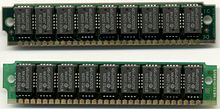Single inline memory module
A Simm (short SIMM ) (English for:. Einzelreihiger memory module ) is a design of memory modules , predominantly for use as memory in computers has been developed. SIMMs were built for use with Fast Page Mode DRAM (FPM) and later also Extended Data Output RAM (EDO- RAM ) and are now (2004) only used in devices such as printers or routers . Compared to the individual memory modules that are widely used in home computers and also in 80286 and 80386 systems, SIMMs allow a considerably simplified assembly, less space requirement, higher operational reliability and lower costs. In later 80386 systems, and especially in 80486 systems, SIMMs are widely used. In the PC, they have been replaced by PS / 2 SIMM modules since around 1993 . The transition took place in the late 80486 systems. On motherboards from the transitional period, both four SIMM slots found partly in two or three PS / 2 SIMM slots. The last 80486 motherboards only have two to four PS / 2 SIMM slots.
Designs
SIM modules come in three types:
- For an 8-bit data bus width, a module with 30 contact pins is initially defined. In PC systems with 80286 or 80386SX processors , a 16-bit memory connection is usually implemented with these modules by installing two 8-bit modules that are controlled in parallel in the system. Computer with a 32-bit memory bus, such as B. 80486 systems require four such modules for each memory bank. The module is approx. 90 mm wide and 18 mm high. So that it cannot be inserted the wrong way round, it is provided with a recess on one side (see picture).
- SIPP modules ( Single Inline Pin Package ) are only common in the FPM variant, otherwise electrically identical . Instead of the contact surfaces, these are equipped with pins for mounting in socket strips. Since there is no mechanical coding in this version , they can also be installed the wrong way round or offset and thus destroyed when the computer is switched on. Often, but not always, SIPP modules could also be used in SIMM sockets after unsoldering the connection pins. In another direction, there are adapters with which SIMM modules could be used in SIPP slots.
- The PS / 2-SIMM module with 72 contact pins will later be developed for 32-bit data width , which enables considerable space savings. During the transition period, a so-called Simmshuttle could be used to insert four or eight SIMM modules into a PS / 2 slot.
In contrast to DIMM modules , which, with the exception of SO-DIMMs, are always pushed in perpendicularly to the motherboard , SIMM modules are inserted at a slight angle into the socket without the use of force and fixed by being folded up using a spring latch.
Storage sizes
30-pin SIM and SIPP modules in 256- KiB , 1- MiB and 4-MiB variants are common, 16-MiB variants are hardly common because of their high price at the time. The 72-pin PS / 2 SIMMs are available in sizes between 1 MiB and 128 MiB per module, with the sizes 4 MiB, 8 MiB, 16 MiB and 32 MiB being the most common.
Web links
Individual evidence
- ↑ Compare also Dual Inline Memory Module (DIMM) ( double row memory module )
- ↑ picture of Simmshuttles (4-er and 8-er)





